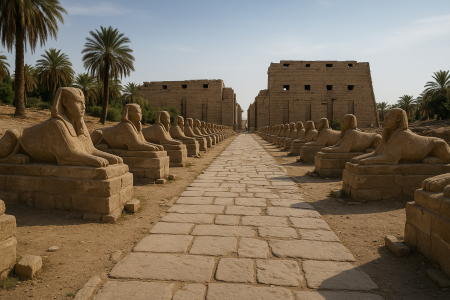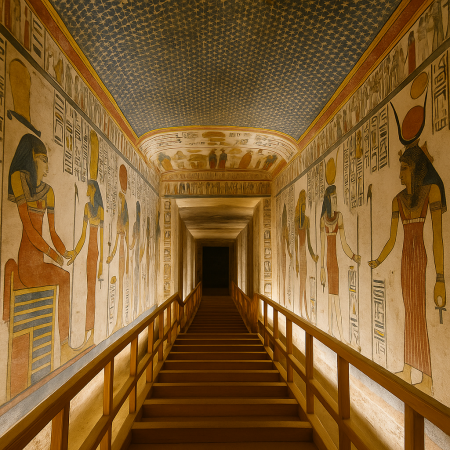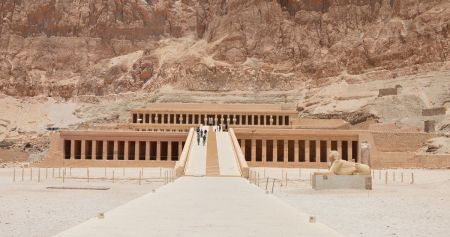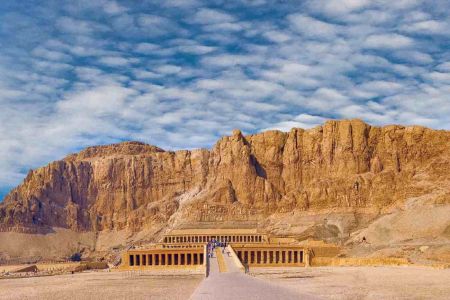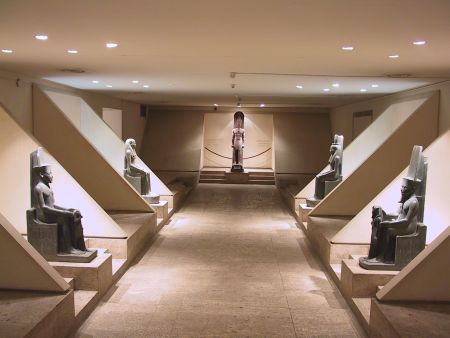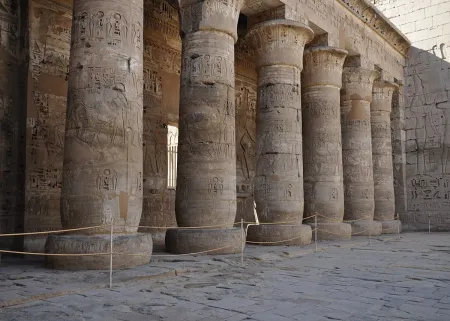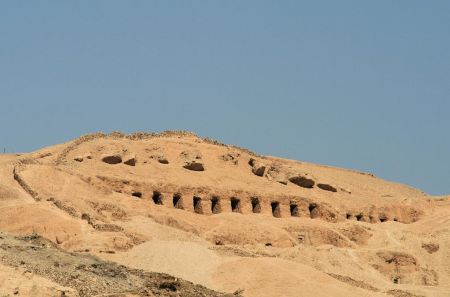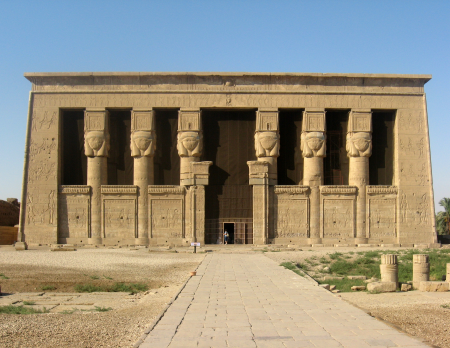Colossi of Memnon : The Stone Sentinels of Ancient Thebes
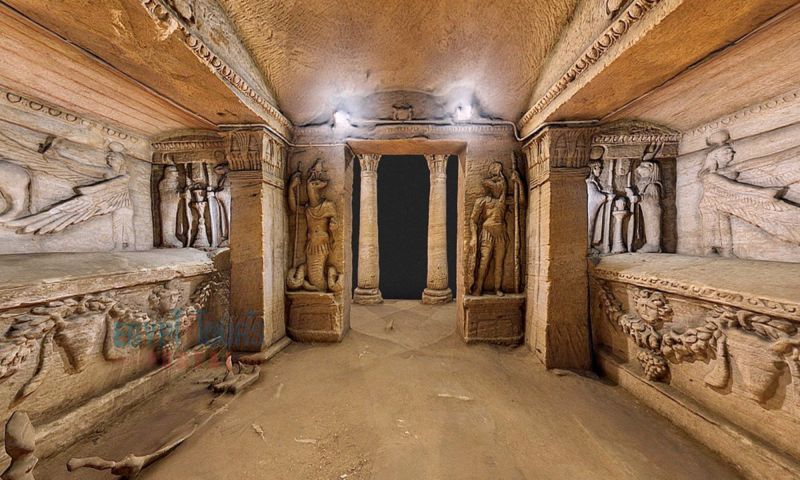
Standing tall on the western plains of Luxor, the Colossi of Memnon are two towering statues that have captivated travelers, historians, and archaeologists for over two millennia. Rising to a height of nearly 18 meters (60 feet), these monumental stone figures represent Pharaoh Amenhotep III, ruler of Egypt during its 18th Dynasty, and are the last remnants of what was once one of the most magnificent temples in all of ancient Egypt.
These giant seated statues originally stood at the entrance of Amenhotep III’s mortuary temple, a structure that, at its peak, surpassed even the Karnak complex in scale and grandeur. Although the temple was mostly destroyed by floods and earthquakes over time, the Colossi of Memnon remained upright, resilient, and awe-inspiring—a testament to the engineering mastery of ancient Egyptian artisans.
Named “Memnon” by the Greeks, who associated the statues with the Trojan War hero, the site gained fame in antiquity for the mysterious "singing" of the northern colossus at dawn. This phenomenon drew Roman emperors, poets, and philosophers alike, cementing the Colossi’s place in history as both royal monuments and mythic wonders.
Historical Context – The Legacy of Pharaoh Amenhotep III
Amenhotep III and the Golden Age of Egypt
Pharaoh Amenhotep III reigned from approximately 1391–1353 BCE, a period often considered the height of Egypt’s imperial power and artistic achievement. Known for his diplomatic prowess and ambitious building projects, he commissioned a grand mortuary temple on the west bank of the Nile near Thebes (modern-day Luxor). The Colossi of Memnon flanked the temple’s entrance, embodying divine kingship and eternal vigilance.
A Temple Lost to Time
Though once larger than any other religious complex in Egypt, Amenhotep III’s mortuary temple now lies in ruins. Much of it was damaged by Nile floods and the high water table, while later pharaohs reused its materials for other monuments. Today, only the two colossal statues remain as witnesses to the temple's former glory.
Architectural and Artistic Features of the Colossi
Structure and Dimensions
Each colossus is carved from blocks of quartzite sandstone brought from quarries near Cairo, over 675 km (420 miles) away. The statues depict Amenhotep III seated on a throne, hands resting on knees, gazing east toward the rising sun. He wears the royal nemes headdress, symbolizing his divine status.
Each statue weighs an estimated 720 tons and reaches 18 meters in height. The sides of the thrones feature carvings of the Nile god Hapi, papyrus and lotus plants symbolizing Upper and Lower Egypt, and figures representing conquered peoples.
Craftsmanship and Symbolism
Despite centuries of damage, the Colossi of Memnon still display exceptional detailing in their carvings. The facial features, though eroded, exhibit the serene and idealized style characteristic of 18th Dynasty portraiture. Their sheer scale, symmetry, and positioning reflect the ancient Egyptians’ emphasis on order, power, and harmony with the cosmos.
The Legend of the Singing Statue – A Sound that Echoed Through History
The Mysterious Morning Song
Beginning in the 3rd century BCE, visitors reported hearing a musical sound—like a whistle or harp note—emerging from the northern statue at dawn. Ancient Greeks attributed this phenomenon to Memnon, son of Eos, goddess of the dawn, greeting his mother each morning. As a result, the statues became known collectively as the Colossi of Memnon.
Scientific Explanations and Sudden Silence
Modern science suggests the sound was caused by the expansion and contraction of stone due to temperature changes and trapped moisture, particularly after an earthquake cracked the statue in 27 BCE. Interestingly, after Roman Emperor Septimius Severus restored the statue in 199 CE, the mysterious song stopped. Whether the repairs altered the acoustics or the phenomenon naturally ceased remains unknown.
Cultural Influence and Ancient Tourism
A Destination for Pilgrims and Poets
The Colossi of Memnon became a popular destination for ancient tourists, particularly Greeks and Romans. Pilgrims believed the singing statue had prophetic powers, and many left inscriptions on the statue's legs and base—some of which remain visible today. Roman emperors, including Hadrian and Septimius Severus, visited the site, cementing its fame across the classical world.
Literary References in Antiquity
The phenomenon inspired countless writings by ancient historians and poets, including Pausanias, Strabo, and Pliny the Elder. These texts helped immortalize the Colossi of Memnon not only as monuments but also as symbols of wonder and divine communication.
Take the stress out of planning with our all-inclusive Egypt Travel Packages
Rediscovery and Modern Preservation Efforts
Excavation and Restoration
In the late 19th and 20th centuries, archaeological teams began excavating the temple complex surrounding the Colossi of Memnon. Recent efforts led by Egyptian and international teams have uncovered additional statues, pillars, and foundation blocks, offering new insights into the temple’s original scale and design.
Ongoing Conservation Work
Preserving these statues remains a challenge due to environmental factors like Nile flooding, temperature fluctuations, and tourism. Restoration teams focus on structural reinforcement, cleaning, and water drainage systems to protect the colossi from further deterioration.
Visiting the Colossi of Memnon – What You Need to Know
Location and Access
The statues are located in the Theban Necropolis on Luxor’s west bank, near the Valley of the Kings and Medinet Habu. Entry is free, and they can be seen from the road, making them a convenient stop on any West Bank itinerary.
Best Time for Photography and Exploration
Early morning is ideal for photography, especially when the statues are lit by the golden light of sunrise. It’s also the best time to avoid crowds and explore the nearby ruins in cooler weather.
Searchable FAQs about the Colossi of Memnon
What are the Colossi of Memnon?
They are two massive stone statues of Pharaoh Amenhotep III that stood at the entrance of his mortuary temple near Luxor.
Why are they called “Memnon”?
The Greeks believed the statues represented the Trojan hero Memnon and named them after hearing mysterious sounds from one of the statues at dawn.
What caused the statues to “sing”?
The sounds were likely caused by temperature shifts, dew evaporation, and vibrations within the cracked stone after an ancient earthquake.
Can tourists visit the Colossi of Memnon?
Yes, the site is free to visit and located near other major attractions on Luxor’s west bank.
Are there other ruins around the statues?
Yes, ongoing excavations have revealed parts of Amenhotep III’s mortuary temple, including additional statues, pillars, and altars.
Conclusion – The Eternal Watchers of Luxor
The Colossi of Memnon are more than just monumental statues—they are symbols of a civilization that revered its kings as divine, honored art as eternal, and saw death as a passage to a higher realm. Whether admired for their sheer scale, mythical associations, or historic endurance, these ancient guardians remain an essential stop for anyone seeking the grandeur of ancient Egypt. As you stand at their feet, dwarfed by their presence, you’re not just seeing a piece of history—you’re standing in the shadow of eternity.


